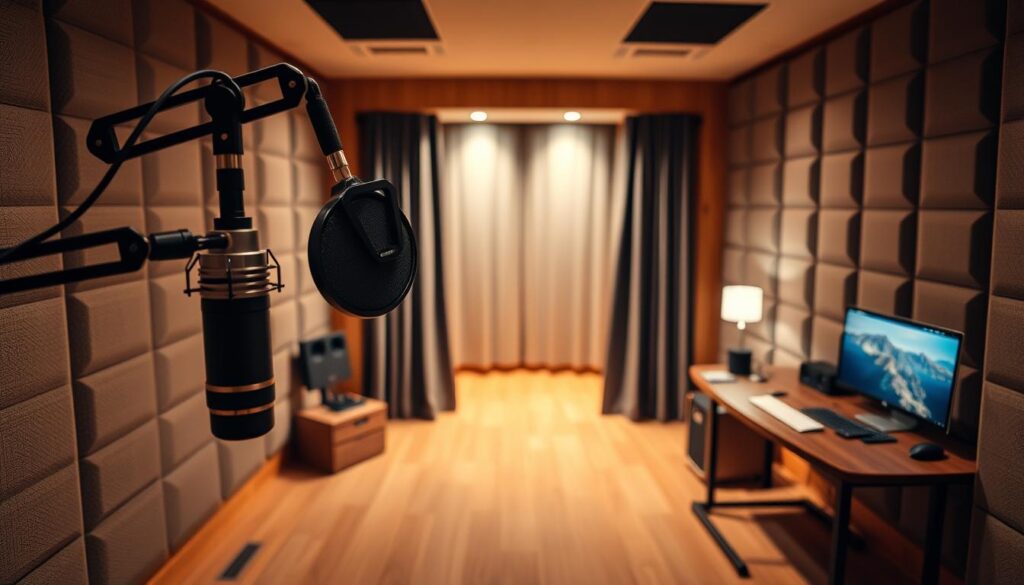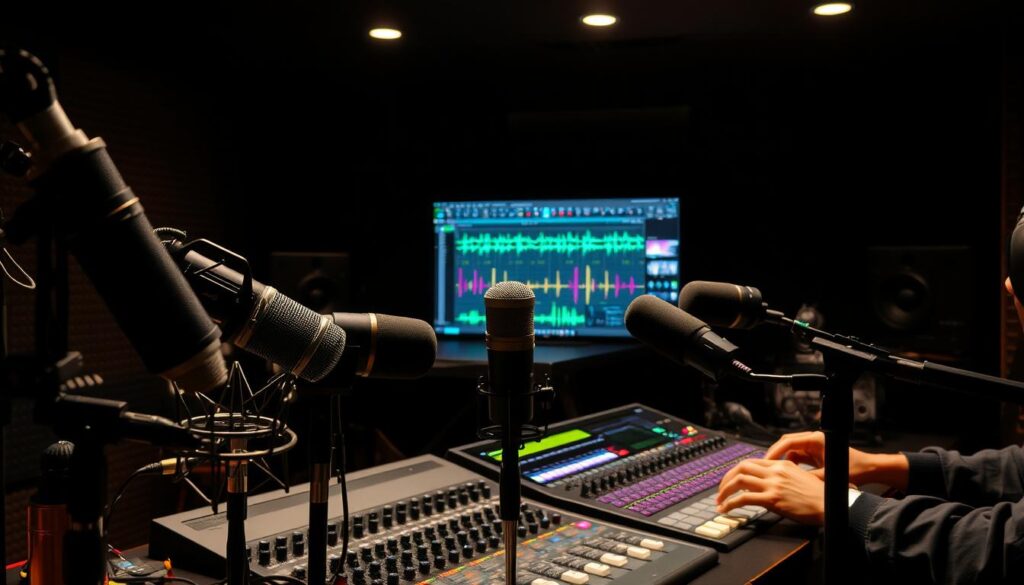Creating a top-notch podcast studio needs careful thought about the right gear, setup, and secrets. You must pick the best equipment, like microphones, audio interfaces, and software. Soundproofing and recording techniques are key to making your podcasts sound professional.
Setting up a podcast studio starts with knowing the basics of choosing the right equipment and designing your studio. You need to pick the best microphones, audio interfaces, and software for your podcast. With the right gear and setup, your podcast will sound polished and professional. Good soundproofing and recording techniques are also crucial for quality audio.
To make a successful podcast, you need a well-designed studio with the right equipment and setup. This means investing in quality microphones, audio interfaces, and software. By following best practices and using the right gear, you can create engaging and informative podcasts for your audience.
Key Takeaways
- Invest in quality microphones and audio interfaces for your podcast studio
- Choose the right software solutions for recording and editing your podcasts
- Implement effective soundproofing techniques to reduce echo and noise
- Follow best practices for recording techniques to ensure high-quality audio
- Select the right equipment and setup for your podcasting needs
Essential Components of a Professional Podcast Studio
Setting up a professional podcast studio needs careful thought. You must focus on the core podcast studio equipment for quality recordings. This includes a good microphone, headphones, audio interface, and pop filter. Knowing the audio chain basics is key to picking the right gear and setting up your studio right.
Creating a smart budget planning plan is crucial to avoid spending too much. By focusing on the must-have podcasting tools and studio essentials, you can build a functional studio without overspending. Key components to consider are:
- Microphones: Choose a high-quality microphone that suits your recording style
- Headphones: Invest in good-quality headphones for accurate monitoring
- Audio interface: Select an audio interface that meets your recording needs
- Pop filter: Use a pop filter to reduce plosive sounds and improve audio quality
By focusing on these key components and smart budget planning, you can set up a professional podcast studio. Remember to research and compare different podcast studio equipment to find the best fit for your needs and budget.
Selecting the Right Microphone for Your Podcast
Choosing the right podcast microphones can be tough. There are many options, and you need to think about your budget, recording style, and what you like. The best microphones for podcasting can really improve your podcast’s sound. So, picking the right one is key.
First, it’s important to know the difference between dynamic and condenser microphones. Also, understand the difference between USB and XLR microphones. This knowledge will help you choose the right microphone for your podcast. Some top picks include the Blue Yeti, Rode NT-USB, and Shure SM7B. Each has its own special features and benefits.
Here are some key things to think about when picking a microphone for your podcast:
- Budget: Decide how much you want to spend on a microphone
- Recording style: Think about the type of podcast you’re doing and where you’ll record it
- Personal preference: Consider what sound quality and features are most important to you
By thinking about these points and looking at the different options, you can find the perfect podcast microphones for your show. Don’t forget to get good podcasting equipment too. It will help make your recordings sound professional.
Audio Interface and Processing Equipment
Recording high-quality podcasts needs the right equipment. An audio interface is key, linking your microphones and gear to your computer. Look for an interface that fits your needs, like inputs, computer compatibility, and price.
Popular choices include USB and Thunderbolt interfaces for quick connections. Also, digital audio workstations (DAW) like Audacity, Adobe Audition, and Logic Pro are vital. They help you record and edit podcasts, with tools for signal processing like compressors and equalizers.
When picking a DAW and audio interface, consider these features:
- Number of inputs and outputs
- Compatibility with your computer and podcast recording software
- Signal processing capabilities, including compression and equalization
- Budget and cost-effectiveness
Choosing the right audio interface and DAW makes your podcasts sound great. With the right tools, you can improve your podcast’s audio quality. This will engage your listeners and elevate your podcast.
| Audio Interface | Number of Inputs | Compatibility |
|---|---|---|
| USB Audio Interface | 2-4 | Windows, Mac |
| Thunderbolt Audio Interface | 4-8 | Mac |
Studio Acoustics and Soundproofing Techniques
Creating a professional-sounding podcast studio requires focus on studio acoustics and soundproofing. A well-designed recording studio design greatly improves recording quality. Techniques like acoustic panels, bass traps, and soundproofing materials are key to a well-treated room.
The placement of equipment and furniture in the studio is crucial for studio acoustics. It greatly affects the room’s acoustic treatment. With the right acoustic treatment and soundproofing, your podcasts will sound clear and professional. This is without the distractions of background noise or echo.

- Using acoustic panels to reduce echo and reverberation
- Installing bass traps to minimize low-frequency sound waves
- Implementing soundproofing materials to prevent external noise from entering the studio
By using these techniques in your recording studio design, you can make a professional-sounding podcast studio. This studio will produce high-quality recordings.
Podcast Studio: Gear, Setup & Secrets for Optimal Recording
Creating a podcast studio needs careful thought about several key points for top-notch recordings. A well-thought-out podcast studio setup is key for professional-sounding podcasts. It’s not just about picking the right gear; it’s also about equipment positioning, cable management, and making the recording environment perfect.
First, placing your microphones, headphones, and other equipment right is vital. This helps avoid noise and interference. A good recording environment is crucial for quality sound. Consider these important points:
- Place microphones for clear and sharp sound
- Use cable management to keep things tidy and protect your gear
- Control factors like temperature, humidity, and lighting in the recording environment
By focusing on these details, you can make a studio perfect for professional podcasts. A well-designed podcast studio setup leads to great recordings and boosts your podcast’s quality.
Advanced Recording Techniques and Best Practices
To improve your podcast, learn advanced recording techniques and follow best practices. This means using your equipment well and getting great audio. Techniques like double-tracking and stereo recording can make your podcast sound richer.
Remember these podcast recording tips: keep a regular schedule, edit well, and take care of your gear. These best practices will make your podcast sound professional and keep your listeners interested. Also, keep up with new podcast production trends to get better.
By using these advanced recording techniques and best practices, you can make your podcast better. Always focus on podcast production quality. Keep looking for ways to get better at what you do.

- Investing in high-quality equipment and software
- Creating a dedicated recording space with optimal acoustics
- Developing a consistent editing and post-production workflow
By working on these areas and improving your podcast recording tips and best practices, you can make a podcast that people love.
Software Solutions for Professional Podcast Production
Creating a high-quality podcast needs the right software. It’s important for recording, editing, streaming, and broadcasting. Podcast production software can make your workflow smoother, improve audio quality, and boost your podcast’s reach.
Many recording software options are out there, like Audacity, Adobe Audition, and GarageBand. They offer features like noise reduction and EQ plugins for professional audio. Also, editing tools like noise reduction software and EQ plugins can enhance your audio.
After recording and editing, it’s time to share your podcast. Streaming platforms like Anchor, Spotify, and Apple Podcasts help you reach more people and make money from your podcasts. Here are some top choices:
- Anchor: A platform for hosting, distributing, and monetizing your podcast
- Spotify: A well-known music streaming service that hosts podcasts too
- Apple Podcasts: A platform for hosting and distributing your podcast to many listeners
Using these software solutions can elevate your podcast and attract more listeners. Whether you’re starting or looking to enhance your podcast, the right podcast production software is key.
Troubleshooting Common Studio Issues
Even with top-notch equipment and software, studio problems can pop up. To keep your podcast production on track, it’s key to tackle common issues fast. This means fixing audio quality problems, technical hiccups, and equipment breakdowns.
Common audio issues include bad microphone use, poor acoustic setup, and wrong settings. Technical problems like software crashes or hardware failures can be avoided with regular upkeep. Equipment maintenance is vital to keep your studio running smoothly. Regular checks can spot issues before they get worse.
To solve common studio problems, follow these steps:
- Find out what’s causing the trouble: Is it audio, tech, or equipment?
- Double-check your gear: Make sure everything is set up right.
- Keep your gear in top shape: Regular checks prevent tech issues and keep things running well.
By being proactive in troubleshooting, you can cut down on downtime. Focus on audio quality issues, technical glitches, and equipment maintenance. This will keep your studio running smoothly and efficiently.
Conclusion: Creating Your Podcast Success Story
Starting your podcasting journey is a long-term commitment. It needs dedication, persistence, and a desire to keep learning. By mastering podcast production and setting up a professional studio, you can make a podcast that connects with your audience.
Don’t be afraid to face challenges and learn from your mistakes. Stay open to changes in the podcasting world. With each episode, you’ll get better at your craft and attract a loyal audience.
The real success of a podcast isn’t just in numbers. It’s about making a difference in your listeners’ lives. Focus on creating content that matters and sparks conversations. With hard work, creativity, and a love for podcasting, you can write your own success story.



